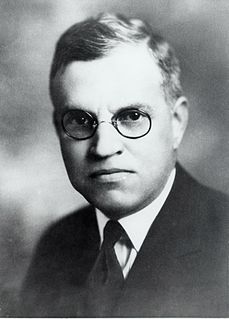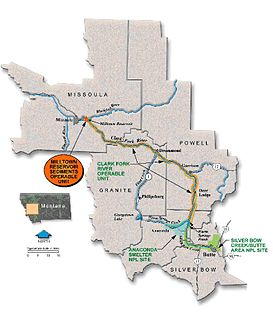
Deer Lodge County is a county in the U.S. state of Montana. As of the 2010 United States Census, the population was 9,298. It forms a consolidated city-county government with its county seat of Anaconda. The county was established in 1865.

Deer Lodge is an incorporated city in, and the county seat of, Powell County, Montana, United States. The population was 3,111 at the 2010 census. The city is perhaps best known as the home of the Montana State Prison, a major local employer. The Montana State Hospital in Warm Springs, and former state tuberculosis sanitarium in nearby Galen are the result of the power the western part of the state held over Montana at statehood due to the copper and mineral wealth in that area. Deer Lodge was also once an important railroad town, serving as a division headquarters for the Chicago, Milwaukee, St. Paul and Pacific Railroad before the railroad's local abandonment in 1980.

Butte is the county seat of Silver Bow County, Montana, United States. In 1977, the city and county governments consolidated to form the sole entity of Butte-Silver Bow. The city covers 718 square miles (1,860 km2), and, according to the 2010 census, has a population of 33,503, making it Montana's fifth largest city. It is served by Bert Mooney Airport with airport code BTM.

The Clark Fork, or the Clark Fork of the Columbia River, is a river in the U.S. states of Montana and Idaho, approximately 310 miles (500 km) long. The largest river by volume in Montana, it drains an extensive region of the Rocky Mountains in western Montana and northern Idaho in the watershed of the Columbia River. The river flows northwest through a long valley at the base of the Cabinet Mountains and empties into Lake Pend Oreille in the Idaho Panhandle. The Pend Oreille River in Idaho, Washington, and British Columbia, Canada which drains the lake to the Columbia in Washington, is sometimes included as part of the Clark Fork, giving it a total length of 479 miles (771 km), with a drainage area of 25,820 square miles (66,900 km2). In its upper 20 miles (32 km) in Montana near Butte, it is known as Silver Bow Creek. Interstate 90 follows much of the upper course of the river from Butte to Saint Regis. The highest point within the river's watershed is Mount Evans at 10,641 feet (3,243 m) in Deer Lodge County, Montana along the Continental Divide.

Anaconda, county seat of Deer Lodge County, which has a consolidated city-county government, is located in southwestern Montana, United States. Located at the foot of the Anaconda Range, the Continental Divide passes within 8 mi (13 km) south of the community. As of the 2020 census the population of the consolidated city-county was 7,989, with a median household income of $40,992. It had earlier peaks of population in 1930 and 1980, based on the mining industry. As a consolidated city-county area, it ranks as the ninth most populous city in Montana, but as only a city is far smaller. Central Anaconda is 5,335 ft (1,626 m) above sea level, and is surrounded by the communities of Opportunity and West Valley.

The Beaverhead–Deerlodge National Forest is the largest of the National Forests in Montana, United States. Covering 3.36 million acres (13,600 km2), the forest is broken into nine separate sections and stretches across eight counties in the southwestern area of the state. President Theodore Roosevelt named the two forests in 1908 and they were merged in 1996. Forest headquarters are located in Dillon, Montana. In Roosevelt's original legislation, the Deerlodge National Forest was called the Big Hole Forest Reserve. He created this reserve because the Anaconda Copper Mining Company, based in Butte, Montana, had begun to clearcut the upper Big Hole River watershed. The subsequent erosion, exacerbated by smoke pollution from the Anaconda smelter, was devastating the region. Ranchers and conservationists alike complained to Roosevelt, who made several trips to the area. (Munday 2001)

The Anaconda Smelter Stack is the tallest surviving masonry structure in the world, with an overall height of about 585 feet (178.3 m), including a brick chimney 555 feet (169.2 m) tall and the downhill side of a concrete foundation 30 feet (9.1 m) tall. It is a brick smoke stack or chimney, built in 1918 as part of the Washoe Smelter of the Anaconda Copper Mining Company (ACM) at Anaconda, Montana, in the United States. A terra cotta coating covered the entire brick chimney when new, but by the time the smelter closed in 1981, most had eroded away except for the upper 40%, exposing most of its bricks and reinforcing rods. The inside diameter at the bottom of the brick chimney is 76 feet (23.2 m) while that at the top is about 60 feet (18.3 m). The stack and its viewing area are now the two-part Anaconda Smoke Stack State Park.

This is a list of properties and historic districts in Montana that are listed on the National Register of Historic Places. The state's more than 1,100 listings are distributed across all of its 56 counties.

Robert C. Reamer (1873–1938) was an American architect, most noted for the Old Faithful Inn in Yellowstone National Park.

The Butte–Anaconda Historic District is a National Historic Landmark (NHL) that spans parts of Walkerville, Butte and Anaconda, Montana, United States. It has the most resources of any U.S. National Historic Landmark District.

The Waldo Theatre is a historic movie theater and performance venue at 916 Main Street in Waldoboro, Maine. Built in 1936 as a movie theater to a design by New York City architect Benjamin Schlanger, it was hailed at the time as one of the best-designed state-of-the-art small theaters in the country. It is now managed by a non-profit arts organization. It was listed on the National Register of Historic Places in 1986.

The Milltown Reservoir Sediments Superfund Site is a major Superfund site in Missoula County, Montana, seven miles east of Missoula. It was added to the National Priorities List in 1983 when arsenic groundwater contamination was found in the Milltown area. The contamination resulted from a massive flood three years after its construction in 1905, which washed millions of tons of mine waste into the Clark Fork River, ultimately ending up behind the Milltown Dam.

The Club Moderne is a bar in Anaconda, Montana, United States, in the Streamline Moderne style. It was designed by architect Fred F. Willson and built by Frank Wullus in 1937 for John Francisco. The facade was clad in Carrara glass. The interior was similarly custom-designed and remained in a high state of preservation, with appropriate renovations in 1948. Chosen as "America's Favorite Historic Bar" in 2016 in a contest sponsored by the National Trust for Historic Preservation, beating out another notable Montana venue, the Sip 'n Dip Lounge, The building was heavily damaged by fire on the evening of October 3, 2016. The current owner, who owned the bar since 1997, expressed an intent to rebuild. Following a soft reopening on April 28, 2017, the remodeled bar reopened to the public on May 13, 2017. The owners had to replace much of the interior and refurbish the exterior, but attempted to retain its traditional look and feel. The bar and a few original furnishings were preserved along with some of the original facade.

This is a list of the National Register of Historic Places listings in Deer Lodge County, Montana. It is intended to be a complete list of the properties and districts on the National Register of Historic Places in Deer Lodge County, Montana, United States. All sites are located in the city of Anaconda, which is consolidated with Deer Lodge County. The locations of National Register properties and districts for which the latitude and longitude coordinates are included below, may be seen in a map.

The Ancient Order of Hibernians Hall, also known as Hibernian Hall, was a historic building in Anaconda, Montana, United States, that is listed on the National Register of Historic Places.

Silver Bow Creek is a 26-mile-long (42 km) headwater stream of the Clark Fork (river) originating within the city limits of Butte, Montana, from the confluence of Little Basin and Blacktail Creeks. A former northern tributary, Yankee Doodle Creek, no longer flows directly into Silver Bow Creek as it is now captured by the Berkeley Pit. Silver Bow Creek flows northwest and north through a high mountain valley, passing east of Anaconda, Montana, where it becomes the Clark Fork at the confluence with Warm Springs Creek.
Liebenberg and Kaplan (L&K) was a Minneapolis architectural firm founded in 1923 by Jacob J. Liebenberg and Seeman I. Kaplan. Over a fifty-year period, L&K became one of the Twin Cities' most successful architectural firms, best known for designing/redesigning movie theaters. The firm also designed hospitals, places of worship, commercial and institutional buildings, country clubs, prestigious homes, radio and television stations, hotels, and apartment buildings. After designing Temple Israel and the Granada Theater in Minneapolis, the firm began specializing in acoustics and theater design and went on to plan the construction and/or renovation of more than 200 movie houses throughout Minnesota, North and South Dakota, Iowa, and Wisconsin. Architectural records, original drawings, and plans for some 2,500 Liebenberg and Kaplan projects are available for public use at the Northwest Architectural Archives.

The Anaconda Commercial Historic District is a historic district in Anaconda, Montana, United States, that is listed on the National Register of Historic Places.

The Butte, Anaconda and Pacific Railway Historic District is a 750 acres (300 ha) historic district which was listed on the National Register of Historic Places in 1988. It covers the railway right-of-way which begins in Butte, Montana and runs to Anaconda generally along the course of Silver Bow Creek. It spans parts of Deer Lodge and Silver Bow counties. The listing included 51 contributing buildings, 34 contributing structures, and two contributing sites.

The Deer Lodge County Courthouse, in Anaconda, Montana, was built in 1898. It was listed on the National Register of Historic Places in 1978.























